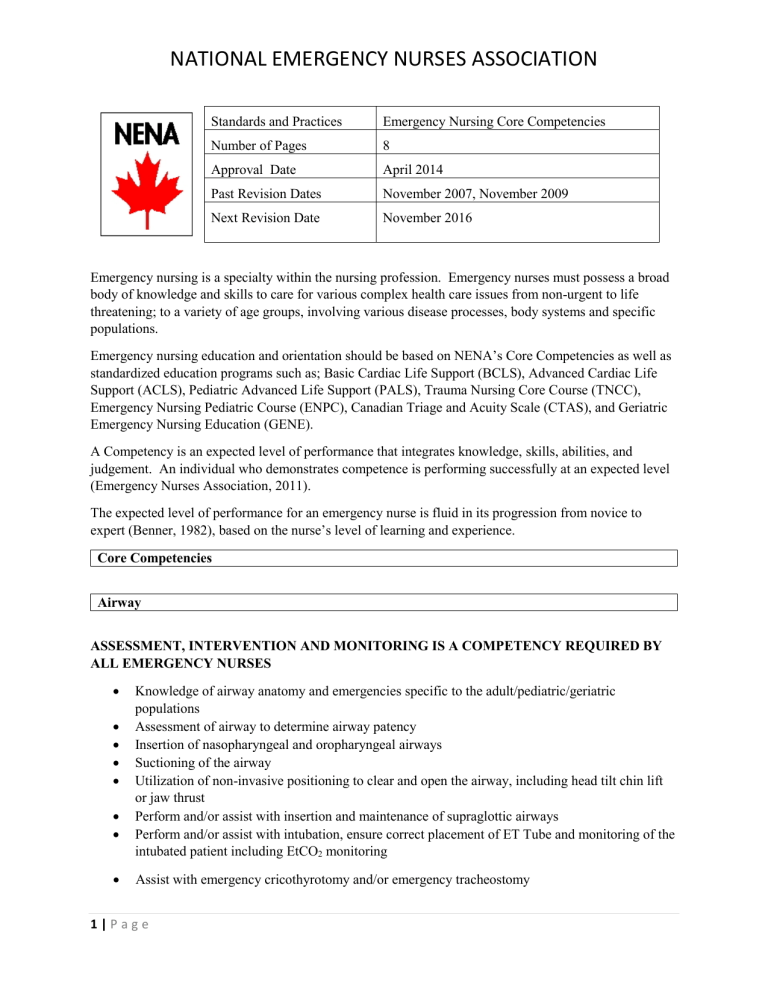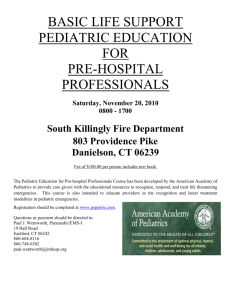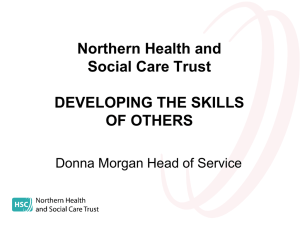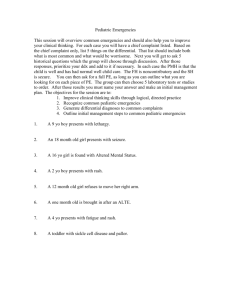NENA Core Competencies

NATIONAL EMERGENCY NURSES ASSOCIATION
Standards and Practices
Number of Pages
Approval Date
Past Revision Dates
Next Revision Date
Emergency Nursing Core Competencies
8
April 2014
November 2007, November 2009
November 2016
Emergency nursing is a specialty within the nursing profession. Emergency nurses must possess a broad body of knowledge and skills to care for various complex health care issues from non-urgent to life threatening; to a variety of age groups, involving various disease processes, body systems and specific populations.
Emergency nursing education and orientation should be based on NENA’s Core Competencies as well as standardized education programs such as; Basic Cardiac Life Support (BCLS), Advanced Cardiac Life
Support (ACLS), Pediatric Advanced Life Support (PALS), Trauma Nursing Core Course (TNCC),
Emergency Nursing Pediatric Course (ENPC), Canadian Triage and Acuity Scale (CTAS), and Geriatric
Emergency Nursing Education (GENE).
A Competency is an expected level of performance that integrates knowledge, skills, abilities, and judgement. An individual who demonstrates competence is performing successfully at an expected level
(Emergency Nurses Association, 2011).
The expected level of performance for an emergency nurse is fluid in its progression from novice to expert (Benner, 1982), based on the nurse’s level of learning and experience.
Core Competencies
Airway
ASSESSMENT, INTERVENTION AND MONITORING IS A COMPETENCY REQUIRED BY
ALL EMERGENCY NURSES
Knowledge of airway anatomy and emergencies specific to the adult/pediatric/geriatric populations
Assessment of airway to determine airway patency
Insertion of nasopharyngeal and oropharyngeal airways
Suctioning of the airway
Utilization of non-invasive positioning to clear and open the airway, including head tilt chin lift or jaw thrust
Perform and/or assist with insertion and maintenance of supraglottic airways
Perform and/or assist with intubation, ensure correct placement of ET Tube and monitoring of the intubated patient including EtCO
2
monitoring
Assist with emergency cricothyrotomy and/or emergency tracheostomy
1 | P a g e
Breathing
NATIONAL EMERGENCY NURSES ASSOCIATION
ASSESSMENT, INTERVENTION AND MONITORING OF RESPIRATORY STATSUS IS A
COMPETENCY REQUIRED BY ALL EMERGENCY NURSES
Knowledge of respiratory anatomy and emergencies specific to the adult/pediatric/geriatric populations (e.g. asthma, croup, bronchiolitis, epiglottitis, COPD, pulmonary edema, pulmonary embolus)
Assessment of effective versus ineffective ventilations
Chest auscultation and identification of normal and abnormal breath sounds
Knowing when to administer oxygen, the amount and by the appropriate means
Using a bag-valve mask device
Perform and/or assist with arterial/venous/capillary blood sampling
Interpretation of blood gas results
Assist with setting up, insertion of chest tubes, and monitoring chest tube drainage
Interpretation and monitoring of oxygen saturation
Collection of peak flow measurements
Identification of life threatening respiratory conditions and perform and/or assist with appropriate interventions
Care of CPAP and ventilated patient in the emergency department
Circulation
ASSESSMENT, INTERVENTION AND MONITORING OF CIRCULATORY STATUS IS A
COMPETENCY REQUIRED BY ALL EMERGENCY NURSES
Recognition and treatment of shock syndromes for the adult/pediatric/geriatric patient:
cardiogenic, hypovolemic, distributive, and obstructive
Initiates early sepsis screening and interventions
Interpretation of vital signs
Assessment of effective circulation in the pediatric patient (central and peripheral pulses, capillary refill, skin color, temperature and moisture)
Auscultation and identification of normal and abnormal heart sounds
Perform and maintain IV access
Perform and/or assist with insertion and maintenance of intraosseous access
Understanding/utilizing principles of rapid fluid administration/devices
Understands/utilizes principles of blood transfusion
Understanding/utilizing principles of massive transfusion
Administering all types of fluid replacement (i.e. crystalloids, plasma expanders, blood products)
Interpretation of lab values
Assist with insertion of central venous and arterial lines
Accessing and drawing blood from central lines and intravenous access devices
2 | P a g e
NATIONAL EMERGENCY NURSES ASSOCIATION
Maintenance of a normothermic environment (i.e. warming/cooling blankets, warmed fluids, etc.)
Cardiovascular
INITIAL CARDIOVASCULAR ASSESSMENT, INTERVENTION AND MONITORING IS A
COMPETENCY REQUIRED BY ALL EMERGENCY NURSES
Assessment and knowledge of interventions for Acute Coronary Syndromes
Basic cardiac monitoring and interpretation
Perform and interpret 12 and 15/16 lead ECG’s
Knowledge of Fibrinolytic protocols
Knowledge of Targeted Temperature Management protocols
Perform and/or assist with defibrillation, cardioversion and external pacing
Assist with pericardiocentesis
Knowledge and interventions related to pharmacology and protocols for the cardiovascular system (i.e. antiarrhythmics, antihypertensives, vasopressors, inotropes)
Neurological
INITIAL NEUROLOGICAL ASSESSMENT, INTERVENTION AND MONITORING IS A
COMPETENCY REQUIRED BY ALL EMERGENCY NURSES
Knowledge of neurological emergencies specific to the adult/pediatric/geriatric populations
Assessment of level of consciousness
Interpretation of neurological signs and symptoms in context with history
Assessment of Glasgow Coma Scale
Assessment and knowledge of appropriate interventions for headaches
Assessment and knowledge of appropriate interventions for seizures
Assessment and knowledge of interventions for head injury (e.g. increased intracranial pressure, and administration of hyperosmotics such a Mannitol)
Assessment and knowledge of and interventions for TIA and stroke (e.g. National Institutes of
Health Stoke Scale, The 8 D’s of Stroke Care)
Knowledge of Fibrinolytic protocols
Assessment and knowledge of interventions for spinal cord/vertebral injury
Perform and/or assist with application of cervical collars
Perform and/or assist with spinal stabilization/immobilization
Non-pharmacological pain management therapies
Evaluation of pain utilizing an appropriate pain scale (e.g. numerical 1-10, FACES, FLACC)
Pharmacological management of pain
Assessment and knowledge of interventions for organic brain syndrome (dementia and
Alzheimer’s disease)
Assessment and knowledge of interventions for acute confusional state (delirium)
3 | P a g e
NATIONAL EMERGENCY NURSES ASSOCIATION
Physical Assessment and Intervention
PHYSICAL ASSESSMENT IS A COMPETENCY REQUIRED BY ALL EMERGENCY NURSES
Maxillofacial, Eye, Ear, Nose and Throat
Knowledge of EENT emergencies specific to the adult/pediatric/geriatric populations (e.g. Otitis, peritonsillar abscess, foreign body, sensory changes, angioedema, epistaxis)
Measure visual acuity
Perform eye irrigation (e.g. Morgan Lens insertion and care)
Assess and assist in management of epistaxis (e.g. nasal packing and balloon catheters)
Assess and assist in management of post tonsillectomy hemorrhage
Assist with removal of foreign body
Assist with care of displaced teeth and/or replantation
Assist with incision and drainage of peritonsillar abscess
Abdomen
Knowledge of abdominal emergencies specific to the adult/pediatric/geriatric populations (e.g. obstructed bowel, GI bleed, pancreatitis, cholecystitis, appendicitis, pyloric stenosis,
intussusception, constipation, diarrhea)
Inspection, auscultation, and palpation of abdomen
Insertion of nasogastric or orogastric tubes
Assist with diagnostic peritoneal lavage
Assessment and care of ostomy
Rectal and esophageal temperature monitoring
Rectal tube insertion
Monitor percutaneous feeding tube
Genitourinary
Knowledge of genitourinary emergencies for males/females specific to the adult/pediatric/geriatric populations (e.g. renal colic, urinary tract infections, pyelonephritis, hematuria, urinary retention, acute/chronic renal failure)
Insertion/application and care of urinary/condom catheters
Knowledge of catheter associated UTI (CAUTI)
Assist with insertion of suprapubic catheters
Assist with insertion of and monitoring or continuous bladder irrigation
Perform and interpret bladder scans
Perform and interpret urine dipstick tests
Perform and interpret urine pregnancy tests
Assist with collection of urethral swabs
Obtain urine culture samples
Monitor fluid balance (In and Out)
4 | P a g e
NATIONAL EMERGENCY NURSES ASSOCIATION
Reproductive Female
Knowledge of reproductive emergencies for females in the adult/pediatric/geriatric populations
(e.g. ectopic pregnancy, ovarian cyst, foreign bodies)
Inspection, auscultation and palpation of the abdomen
Auscultate fetal heart tones
Recognize signs of fetal distress
Estimate PV blood loss
Knowledge of hospital protocol for sexual violence
Assist with pelvic exam, collection of swabs and/or forensic evidence collection
Knowledge of sexually transmitted illnesses
Knowledge of abortion (spontaneous, threatened, therapeutic, septic, missed)
Knowledge of perinatal loss including care of the patient and family
Assessment and knowledge of obstetrical emergencies (abruption placentae, placenta previa, ruptured uterus)
Assist with emergency childbirth (i.e. unexpected delivery, precipitous, meconium stained fluid, breech presentation, cord prolapse, APGAR, care of the newborn)
Reproductive Male
Knowledge of reproductive emergencies for males in the adult/pediatric/geriatric populations
(e.g. testicular torsion, penile/scrotal pain, priapism, prostatitis)
Knowledge of hospital protocol for sexual violence
Knowledge of sexually transmitted illnesses
Musculoskeletal/Integumentary
Knowledge of various musculoskeletal and integumentary emergencies specific to the adult/pediatric/geriatric populations (e.g. fractures, dislocations, amputations, arthritis, osteomyelitis, rashes, cellulitis, necrotizing fasciitis, skin disorders)
Neurovascular assessment of extremities
Assessment of the seven P’s (pain, pallor, polar, paresthesia, pulses, pressure, and paralysis)
Assessment and intervention for compartment syndrome
Assessment and intervention of various pain management strategies
Splinting (R.I.C.E)
Assist with reduction and/or immobilization of fractures and dislocations
Preservation of amputated parts
Performing wound care of the acute and chronic wound
Assisting with wound closure (e.g. suturing, staples, skin glue)
Apply topical anesthetic
Assist with local anesthetic
Ring removal
Environmental
Knowledge of impact of environmental emergencies specific to the adult/pediatric/geriatric populations
5 | P a g e
NATIONAL EMERGENCY NURSES ASSOCIATION
Assessment and interventions of burns
Assessment and interventions of heat stroke/heat exhaustion
Assessment and interventions of near drowning
Assessment and interventions of hypothermia and frostbite
Assessment and interventions of high altitude and decompression illness
Knowledge and assessment of bites and stings (e.g. human, animal, insect, snakes, jellyfish)
Assessment and interventions of bio-terrorism threats/attacks
Knowledge and implementation of staff/patient safety
Knowledge of disaster planning and policies
Toxicology
Knowledge of various toxicological emergencies specific to the adult/pediatric/geriatric populations
Access to poison control information
Knowledge of specific antidote administration
Administration of charcoal
Assist with gastric lavage
Assist with whole bowel irrigation
Knowledge of common poisonings and methods to prevent absorption and enhance elimination
(e.g. sodium bicarbonate, naloxone, N-acetylcysteine, flumazenil, specific antidotes)
Recognition of substance intoxication and abuse
Knowledge of protocols and treatment for substance abuse and withdrawal
Psychiatry
Knowledge of psychiatric emergencies specific to the adult/pediatric/geriatric populations
Selection of appropriate interventions to manage alterations in mental/behavioural health and ensure patient and staff safety
Knowledge of protocols, guidelines, and laws pertaining to patients with mental/behavioural health illnesses
Recognition of escalating behaviour
Recognition of delirium, dementia, and depression in the geriatric population
Knowledge and interventions for mood and personality disorders, anxiety and stress disorders, eating disorders, schizophrenia
Knowledge of suicidal risk assessment
Psychosocial
Provides effective and timely communication to the patient and significant others
Ensures environment that promotes privacy and support
Knowledge of crisis intervention as it relates to the patient, family and significant others
Provision of reassurance, acceptance and encouragement during times of stress
Recognition of signs of abuse in the pediatric/elder/vulnerable patient
Recognition and knowledge of intimate partner violence
Knowledge of cultural awareness and sensitivity
6 | P a g e
NATIONAL EMERGENCY NURSES ASSOCIATION
Immunology/Hematology/Endocrinology
Knowledge of immunologic/hematologic/endocrine emergencies specific to the adult/pediatric/geriatric populations
Assessment and interventions for hyperglycemic emergencies (Diabetic Ketoacidosis,
Hyperglycemic Hyperosmolar Syndrome)
Assessment and interventions for hypoglycemia
Assessment and interventions for thyroid emergencies (e.g. thyroid storm)
Assessment and interventions for adrenal gland emergencies
Assessment and interventions for oncologic emergencies
Assessment and interventions for blood dyscrasias
Assessment and interventions for the immunocompromised patient (e.g. HIV, neutropenia)
Medications
Knowledge of pharmacology and medications
Administers medication safely according to agency policy
Knowledge of medication reconciliation
Discharge Planning
Provides teaching to patient and/or significant others on an ongoing basis
Provides explanations for medications, treatments, self-care, follow up and/or referrals to outside resources
Provides additional discharge instructions via departmental handouts or community prepared documents when available
Consults and coordinates care with specialists, allied health, and additional support services (e.g.
Physiotherapy, social work, occupational therapy, home care, outpatient clinics)
Professional Practice/Legal/Ethical Issues
The Emergency Nurse will be knowledgeable of hospital policies and procedures and provincial or national laws related to:
Sexual violence
Interpersonal violence
Patient restraints
Blood alcohol collection
Abuse of the pediatric, geriatric, or vulnerable patient
Criminal assault
Gunshot or stab wound reporting
Advanced directives
Organ and Tissue donation
Family presence during resuscitation
Medical/legal cases
Informed consent
7 | P a g e
NATIONAL EMERGENCY NURSES ASSOCIATION
Unidentified patients
Workplace violence prevention
Infection Control
Emergency preparedness and planning including pandemic and disaster planning
REFERENCES
Benner, P.E. (1984). From novice to expert: Excellence and power in clinical nursing practice. Menlo
Park, CA: Addison-Wesley.
Canadian Nurses Association. (2012). Emergency Nursing Certification Exam Blueprint and specialty
competencies, Retrieved April 15, 2014 from http://www.nurseone.ca/docs/NurseOne/Certification/Emergency_Blueprint_Oct212_e.pdf#page
=11
Emergency Nurses Association. (2011). Emergency Nursing Scope and Standards of Practice (1 st Ed) ,
Des Plaines, Il: Emergency Nurses Association.
Howard, P.K. & Steinmann, R.A. (2010). Sheehy’s Emergency Nursing Principles and Practice (6 th Ed) .
(Ed) Emergency Nurses Association Mosby Elsevier, St. Louis, MO.
8 | P a g e








